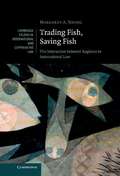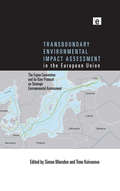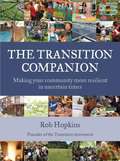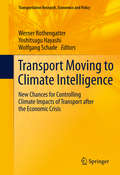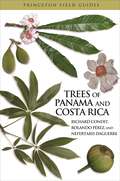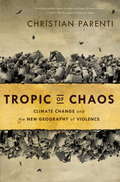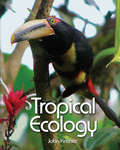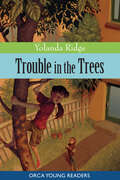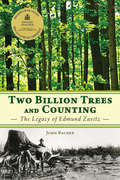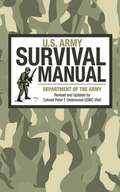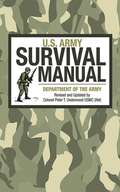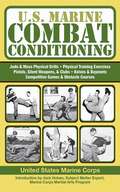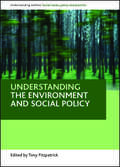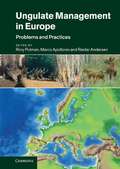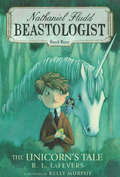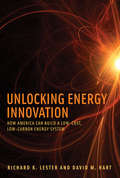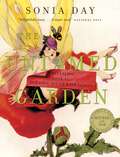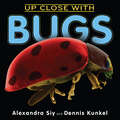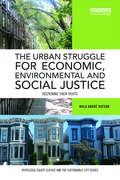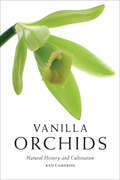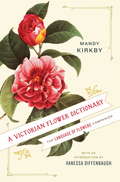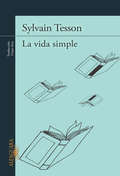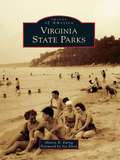- Table View
- List View
Trading Fish, Saving Fish
by Margaret A. YoungNumerous international legal regimes now seek to address the global depletion of fish stocks, and increasingly their activities overlap. The relevant laws were developed at different times by different groups of states. They are motivated by divergent economic approaches, influenced by disparate non-state actors, and implemented by separate institutions such as the World Trade Organisation and the United Nations Food and Agriculture Organisation. Margaret Young shows how these and other factors affect the interaction between regimes. Her empirical and doctrinal analysis moves beyond the discussion of conflicting norms that has dominated the fragmentation debate. Case-studies include the negotiation of new rules on fisheries subsidies, the restriction of trade in endangered marine species and the adjudication of fisheries import bans. She explores how regimes should interact, in fisheries governance and beyond, to offer insights into the practice and legitimacy of regime interaction in international law.
Transboundary Environmental Impact Assessment in the European Union: The Espoo Convention and its Kiev Protocol on Strategic Environmental Assessment
by Timo Koivurova Simon MarsdenThis book examines 'The Espoo Convention on Environmental Impact Assessment in a Transboundary Context', which celebrates the twentieth anniversary of its adoption in 2011, and its 'Kiev Protocol on Strategic Environmental Assessment' which came into force in July 2010. In addition to contributing to international environmental law, the Convention has prompted significant changes to European environmental law. The chapters in this collection explain the role of transboundary environmental impact assessment in international and European law, and explore the relationship between international and European law in the context of potential application of the Convention. They also examine examples of the Convention in practice, and consider the potential application of the Protocol. While the focus of the book is on the situation in the European Union, reference is made to the relationship between EU and non-EU member states, notably in connection with important cases in the Arctic, the Danube Delta and the Baltic Sea.
The Transition Companion
by Rob HopkinsIn this illustrated resource for general readers, Hopkins, founder of the UK'S Transition Movement, advocates a grassroots, community-led response to climate change and oil dependence. The first part of the book explains the rationale behind the need for a new paradigm for communities, reviewing the current and future consequences of oil dependence, climate change, and economic problems, and describes the transition movement's vision for revived communities. The book then describes real initiatives that work for lower energy use, ecological sustainability, and reliance on local economies. Hopkins gives advice on how to start and maintain a transition initiative, covering ingredients for success such as respectful communication, running effective meetings, forming a legal entity, starting local food initiatives, encouraging entrepreneurship, and using less energy. The book's color layout includes color photos and color-coded sections. Annotation ©2012 Book News, Inc. , Portland, OR (booknews. com)
Transport Moving to Climate Intelligence
by Werner Rothengatter Yoshitsugu Hayashi Wolfgang SchadeTransportation contributes to roughly a fifth of greenhouse gas emissions, and as a growing sector of the economy, its contribution to climate change, if remained unchanged, could even grow. This is particularly true in the developing world, where the growth rates of air and ship transport are expected to exceed those of the EU, and worldwide objectives to curb greenhouse gas emissions by 2050 by sixty to eighty percent could be placed in serious jeopardy. This book addresses the key issues of controlling transportation growth and identifying and implementing measures that would significantly reduce the emissions of greenhouse gases from transport while maintaining its vital role in generating prosperity and mobility for future generations. This book describes the challenge that transport constitutes today as well as its role in the future for climate policy. It will discuss and provide hands-on suggestions for transportation policy that will mitigate the greenhouse gas emissions from transport. The book is organized into five parts. Part One presents an overview of transport and climate policy in the context of the recent economic crisis. Part Two examines the problems and proposed solutions for curbing emissions from transport in industrialized countries while Parts Three and Four deal with the developing world, with a particular focus on India and China. Part Five discusses tested solutions and provides policy recommendations making this book of interest to a broad audience of both policy-makers and academics concerned with the role of transport in reducing global climate change.
Trees of Panama and Costa Rica (Princeton Field Guides #74)
by Richard Condit Rolando Pérez Nefertaris DaguerreThis is the first field guide dedicated to the diverse tree species of Panama and Costa Rica. Featuring close to 500 tropical tree species, Trees of Panama and Costa Rica includes superb color photos, abundant color distribution maps, and concise descriptions of key characteristics, making this guide readily accessible to botanists, biologists, and casual nature lovers alike. The invaluable introductory chapters discuss tree diversity in Central America and the basics of tree identification. Family and species accounts are treated alphabetically and describe family size, number of genera and species, floral characteristics, and relative abundance. Color distribution maps supplement the useful species descriptions, and facing-page photographic plates detail bark, leaf, flower, or fruit of the species featured. Helpful appendices contain a full glossary, a comprehensive guide to leaf forms, and a list of families not covered. The only tree guide to cover both Panama and Costa Rica together Covers almost 500 species 438 high-resolution color photos 480 color distribution maps and two general maps Concise and jargon-free descriptions of key characteristics for every species Full glossary and guide to leaf forms included
Tropic of Chaos: Climate Changes and the New Geography of Violence
by Christian ParentiFrom Africa to Asia and Latin America, the era of climate wars has begun. Extreme weather is breeding banditry, humanitarian crisis, and state failure. In Tropic of Chaos, investigative journalist Christian Parenti travels along the front lines of this gathering catastrophe--the belt of economically and politically battered postcolonial nations and war zones girding the planet's midlatitudes. Here he finds failed states amid climatic disasters. But he also reveals the unsettling presence of Western military forces and explains how they see an opportunity in the crisis to prepare for open-ended global counterinsurgency. Parenti argues that this incipient "climate fascism"--a political hardening of wealthy states-- is bound to fail. The struggling states of the developing world cannot be allowed to collapse, as they will take other nations down as well. Instead, we must work to meet the challenge of climate-driven violence with a very different set of sustainable economic and development policies.
Tropical Ecology
by John KricherThis full-color illustrated textbook offers the first comprehensive introduction to all major aspects of tropical ecology. It explains why the world's tropical rain forests are so universally rich in species, what factors may contribute to high species richness, how nutrient cycles affect rain forest ecology, and how ecologists investigate the complex interrelationships among flora and fauna. It covers tropical montane ecology, riverine ecosystems, savanna, dry forest--and more.Tropical Ecology begins with a historical overview followed by a sweeping discussion of biogeography and evolution, and then introduces students to the unique and complex structure of tropical rain forests. Other topics include the processes that influence everything from species richness to rates of photosynthesis: how global climate change may affect rain forest characteristics and function; how fragmentation of ecosystems affects species richness and ecological processes; human ecology in the tropics; biodiversity; and conservation of tropical ecosystems and species.Drawing on real-world examples taken from actual research, Tropical Ecology is the best textbook on the subject for advanced undergraduates and graduate students. Offers the first comprehensive introduction to tropical ecology Describes all the major kinds of tropical terrestrial ecosystems Explains species diversity, evolutionary processes, and coevolutionary interactions Features numerous color illustrations and examples from actual research Covers global warming, deforestation, reforestation, fragmentation, and conservation The essential textbook for advanced undergraduates and graduate students Suitable for courses with a field component
Trouble in the Trees (Orca Young Readers)
by Yolanda RidgeEleven-year-old Bree is happiest when she's climbing the trees at Cedar Grove, her urban townhouse complex. She's the best climber around, even better than an older boy, Tyler, who drives her crazy with his competitiveness. When Ethan, a younger boy, falls from a tree and hurts his elbow, the neighborhood council bans all tree-climbing in Cedar Grove. If Bree chooses to ignore the bylaw, her family could be kicked out of their home, so she vows to change the rule instead. After giving a presentation to the Neighborhood Council, she realizes this is not a battle she can win on her own, but rallying the Cedar Grove troops is more difficult than she imagined.
Turn Left at Orion
by Guy Consolmagno Dan M. DavisA superb guidebook described in Bookwatch as 'the home astronomer's "bible"', Turn Left at Orion provides all the information beginning amateur astronomers need to observe the Moon, the planets and a whole host of celestial objects. Large format diagrams show these objects exactly as they appear in a small telescope and for each object there is information on the current state of our astronomical knowledge. Revised and updated, this new edition contains a chapter with ten new spreads describing spectacular deep sky objects visible from the southern hemisphere, and tips on observing the upcoming transits of Venus. It also discusses Dobsonian telescopes, with hints on using personal computers and the Internet as aids for planning an observing session. Also new to this edition are redrawn "Guidepost" figures at the beginning of each season chapter that allow readers to visualize a three-dimensional view of the sky's dome; redesigned seasonal object layouts that provide more space for the naked-eye charts; a new spread on double stars near Bo_tes has been added to Spring, replacing the "Shrinking Double" spread; and a unique "When and Where to Look" table has been added to the last page, among other new features. Unlike many guides to the night sky, this book is specifically written for observers using small telescopes. Clear and easy to use, this fascinating book will appeal to skywatchers of all ages and backgrounds. No previous knowledge of astronomy is needed.
Two Billion Trees and Counting: The Legacy of Edmund Zavitz
by John Bacher Kenneth A. ArmsonShort-listed for the 2012 Speaker’s Book Award Edmund Zavitz (1875–1968) rescued Ontario from the ravages of increasingly more powerful floods, erosion, and deadly fires. Wastelands were talking over many hectares of once-flourishing farmlands and towns. Sites like the Oak Ridges Moraine were well on their way to becoming a dust bowl and all because of extensive deforestation. Zavitz held the positions of chief forester of Ontario, deputy minister of forests, and director of reforestation. His first pilot reforestation project was in 1905, and since then Zavitz has educated the public and politicians about the need to protect Ontario forests. By the mid-1940s, conservation authorities, provincial nurseries, forestry stations, and bylaws protecting trees were in place. Land was being restored. Just a month before his death, the one billionth tree was planted by Premier John Robarts. Some two billion more would follow. As a result of Zavitz’s work, the Niagara Escarpment, once a wasteland, is now a UNESCO World Biosphere. Recognition of the ongoing need to plant trees to protect our future continues as the legacy of Edmund Zavitz.
U.S. Army Survival Manual (US Army Survival)
by Army Peter T. UnderwoodThis comprehensive new edition of U.S. Army Survival Manual, issued by the Department of the Army and thoroughly revised by Colonel Peter T. Underwood USMC (Ret), is ideal for military personnel and all outdoors enthusiasts. From the psychology of survival and basic medicine to personal camouflage and signaling techniques, this essential resource provides all the information you need to survive. Included here is a guide to identifying: Poisonous snakes and lizards Edible plants Cloud formations as foretellers of weather And more! With detailed photographs and illustrations and an extensive set of appendices, U.S. Army Survival Manual is your ultimate guide to survival in all conditions and environs.
U.S. Army Survival Manual
by Army Peter T. UnderwoodThis comprehensive new edition of U.S. Army Survival Manual, issued by the Department of the Army and thoroughly revised by Colonel Peter T. Underwood USMC (Ret), is ideal for military personnel and all outdoors enthusiasts. From the psychology of survival and basic medicine to personal camouflage and signaling techniques, this essential resource provides all the information you need to survive. Included here is a guide to identifying: Poisonous snakes and lizards Edible plants Cloud formations as foretellers of weather And more! With detailed photographs and illustrations and an extensive set of appendices, U.S. Army Survival Manual is your ultimate guide to survival in all conditions and environs.
U.S. Marine Combat Conditioning (US Army Survival)
by United States Marine Corps.U.S. Marine Combat Conditioning is a complete reproduction of the combat conditioning program that was completed by all World War II-era Officer Candidates while at OCS in Quantico, Virginia. Combat Conditioning is defined as the physical and mental conditioning of individual Marines for hand-to-hand combat and is an essential part of the progressive training of all Marines. In addition to conditioning the Marines physically, the program is designed to help them overcome inhibitions toward physical contact. The goal is not only to gain physical strength, agility, and endurance but also to develop confidence as a hand-to-hand fighter both with and without weapons. Additionally, this manual serves as the guide for individual Marine units when establishing their own combat conditioning programs. An invaluable part of U.S. military history, the lessons remain relevant even to-day. With over 200 photographs, U.S. Marine Combat Conditioning demonstrates-in vivid detail-the exercises and training techniques used by marines to prepare for combat as well as their proper application. The program incorporates mass physical drills, competitive games and exercises, and specially designed obstacle and assault courses. In addition to the rigorous physical training, it includes combat instruction in judo as well as the use of knives, bayonets, clubs, silent weapons, and pistols.
Understanding the environment and social policy (Understanding Welfare: Social Issues, Policy and Practice)
by Tony FitzpatrickBringing together leading experts, this textbook explores the key social, political, economic and moral challenges that environmental problems pose for social policy in a global context. Combining theory and practice with an interdisciplinary approach, the book reviews the current strategies and policies and provides a critique of proposed future developments in the field. Understanding the environment and social policy guides the reader through the subject in an accessible way using chapter summaries, further reading, recommended webpages, a glossary and questions for discussion. Providing a much-needed overview, the book will be invaluable reading for students, teachers, activists, practitioners and policymakers.
Ungulate Management in Europe
by Marco Apollonio Rory Putman Reidar AndersenThis book considers a number of problems posed by ungulates and their management in Europe. Through a synthesis of the underlying biology and a comparison of the management techniques adopted in different countries, the book explores which management approaches seem effective - and in which circumstances. Experts in a number of different areas of applied wildlife biology review various management problems and alternative solutions, including the impact of large ungulates on agriculture, forestry and conservation habitats, the impact of disease and predation on ungulate populations and the involvement of ungulates in road traffic accidents and possible measures for mitigation. This book is directed at practising wildlife managers, those involved in research to improve methods of wildlife management, and policy-makers in local, regional and national administrations.
The Unicorn's Tale (Nathaniel Fludd, Beastologist, Book #4)
by R. L. LaFevers Kelly MurphyIs there no rest for the travel worn and weary? Not if you're Nathaniel Fludd, the world's youngest beastologist-in-training! All Nate really wants is to track down his missing parents, but when a unicorn falls mysteriously ill, Nate's Aunt Phil makes it clear where a beastologist's duty lies: to the beasts. And if taking care of the world's beasts isn't difficult enough, Nate and Aunt Phil must also keep them safe from the villainous Obediah Fludd, who intends to do them harm. With all this taking up every last bit of his energy and time, will Nate ever find the parents he is so absolutely convinced are alive?
University Colloquium: A Sustainable Future
by Florida Gulf Coast UniversityThis book contains extracts from the following books: Last Child in the Woods, Collapse: How Societies Choose to Fail or Succeed, Tomorrow's Biodiversity, A Sand County Almanac, The Swamp: The Everglades, Florida, and the Politics of Paradise, The Everglades: River of Grass, Silent Spring, Hope for Animals and Their World, Earth in Mind: On Education and Environment, and Human Prospect.
Unlocking Energy Innovation: How America Can Build a Low-Cost, Low-Carbon Energy System
by Richard K. Lester David M. HartExperts outline a plan to overhaul the U.S. energy innovation system for accelerated, large-scale adoption of reliable, low-cost, low-carbon energy technologies.Energy innovation offers us our best chance to solve the three urgent and interrelated problems of climate change, worldwide insecurity over energy supplies, and rapidly growing energy demand. But if we are to achieve a timely transition to reliable, low-cost, low-carbon energy, the U.S. energy innovation system must be radically overhauled. Unlocking Energy Innovation outlines an up-to-the-minute plan for remaking America's energy innovation system by tapping the country's entrepreneurial strengths and regional diversity in both the public and private spheres. “Business as usual” will not fill the energy innovation gap. Only the kind of systemic, transformative changes to our energy innovation system described in this provocative book will help us avert the most dire scenarios and achieve a sustainable and secure energy future.
The Untamed Garden: A Revealing Look at Our Love Affair with Plants
by Sonia DayWhich suggestive plant caused a queen to faint when it was presented to her at court? What was the original French name for the Great Maiden's Blush rose that had the Victorians blushing? Why are figs and pomegranates thought to be the real forbidden fruit that led Adam and Eve into temptation?In this delightful gift book, master gardener Sonia Day brings together delicious tidbits from myth, history, botany, and plant lore to reveal how plants have seduced our hearts, minds, and bodies throughout the ages. Organized in thematic chapters that loosely follow the arc of a love affair, the book journeys from "Innocence" (the notion of a virgin being "deflowered" originated with the belief that flowers were pure and sexless), through such stages as "Flirtation," "Seduction," "Lust," "Deception," and "Rapture." Scattered throughout are love potions, examples from the Victorian "language of flowers," and charming anecdotes, all told in Day's delightfully irreverent and conversational voice. Gorgeously designed and featuring full-colour photos and illustrations throughout, this is a sumptuous tribute to our enduring fascination with plants that is sure to seduce readers everywhere.
Up Close With Bugs
by Alexandra SiyAmazing micrograph photography helps readers find out if bugs get an undeserved bad rap in this nonfiction picture book.Bugs bite, drink blood, and eat food in our fields and gardens. Is bugging a crime? Decide for yourself! Read "rap sheets" on the major categories of insects, and marvel at photomicrographs that magnify bug parts by 10 to 300,000 times! But once you've learned about insect habits, you may come to agree that bugs are our friends... not our foes. Meticulous research combined with lively writing and a kid-friendly approach to turn learning about insects into an intriguing case. First published in hardcover as Bug Shots, this title is being repackaged as a companion to Up Close with Spiders (Spidermania).
The Urban Struggle for Economic, Environmental and Social Justice: Deepening their roots (Routledge Equity, Justice and the Sustainable City series)
by Malo André HutsonThis book discusses the current demographic shifts of blacks, Latinos, and other people of colour out of certain strong-market cities and the growing fear of displacement among low-income urban residents. It documents these populations' efforts to remain in their communities and highlights how this leads to community organizing around economic, environmental, and social justice. The book shows how residents of once-neglected urban communities are standing up to city economic development agencies, influential real estate developers, universities, and others to remain in their neighbourhoods, protect their interests, and transform their communities into sustainable, healthy communities. These communities are deploying new strategies that build off of past struggles over urban renewal. Based on seven years of research, this book draws on a wealth of material to conduct a case study analysis of eight low-income/mixed-income communities in Boston, New York, San Francisco, and Washington, DC. This timely book is aimed at researchers and postgraduate students interested in urban policy and politics, community development, urban studies, environmental justice, urban public health, sociology, community-based research methods, and urban planning theory and practice. It will also be of interest to policy makers, community activists, and the private sector.
Vanilla Orchids: Natural History and Cultivation
by Ken CameronWith more than 30,000 known species, orchids represent the largest family of plants. But only one genus has agricultural value—the Vanilla orchid. Leading orchid expert Ken Cameron covers the natural history of the world’s most popular flavor and fragrance and provides an introduction to the pollination, biology, structure, evolution, and diversity of Vanilla and related orchids. Vanilla Orchids also features methods for bean harvest, curing, and processing for enthusiasts who want to try it at home.
A Victorian Flower Dictionary
by Mandy Kirkby Vanessa Diffenbaugh"A flower is not a flower alone; a thousand thoughts invest it." Daffodils signal new beginnings, daisies innocence. Lilacs mean the first emotions of love, periwinkles tender recollection. Early Victorians used flowers as a way to express their feelings--love or grief, jealousy or devotion. Now, modern-day romantics are enjoying a resurgence of this bygone custom, and this book will share the historical, literary, and cultural significance of flowers with a whole new generation. With lavish illustrations, a dual dictionary of flora and meanings, and suggestions for creating expressive arrangements, this keepsake is the perfect compendium for everyone who has ever given or received a bouquet.From the Hardcover edition.
La vida simple
by Sylvain Tesson¿Y si la felicidad consistiera en despojarse de todo? Desde el momento en que supe que no podría hacer gran cosa para salvar al mundo, empecé a pensar en instalarme por un tiempo, solo, en una cabaña. Compré una isba de troncos, lejos de todo, en la orilla del lago Baikal. Allí, durante seis meses, a cinco días de marcha del pueblo más cercano, perdido en una naturaleza desmesurada, traté de ser feliz. Creo haberlo logrado. ¿Y si la libertad consistiera en adueñarse del tiempo? ¿Y si la felicidad fuera disponer de soledad, de espacio y de silencio... cosas de las que carecerán las generaciones futuras? La crítica ha dicho:«Uno de los libros más extraordinarios que recuerdo haber leído hace tiempo... De una hermosura pasmosa que atiende a la epifanía.»Ricardo Menéndez Salmón, La Nueva España «Un libro profundamente ecologista... ¡Imprescindible abordar su lectura con un lápiz y/o bloc de notas!»Antonio Lozano, Qué leer «El libro más estimulante de la nueva temporada literaria.»Metro «Una obra preciosa porque muestra el valor incalculable del tiempo que pasa... Una oda a la inmovilidad y el silencio.»Le Monde «El brío de su erudición y la riqueza de sus referencias se realzan con una verdad humana de insólita autenticidad... Un magnífico escritor que ha narrado su experiencia de felicidad.»La Croix «Cultura, buen humor y una profundidad genuina.»Livres Hebdo «Entre la aventura interior y el sueño de una vida salvaje... Un libro magnético.»Le Monde des Livres «Un libro fascinante que propone volver a un modo de vida que suprime lo inútil, que se concentra en lo esencial... Revolucionario.»La Repubblica «Mucho más que un libro: una propuesta vital.»Le Point «Una experiencia no sólo bella de leer, sino también útil para los tiempos de crisis.»Rolling Stone «El viajero más famoso de Francia ha descubierto que quedarse inmóviles puede ser una exploración aún más vertiginosa que dar la vuelta al mundo en bicicleta. Y lo cuenta en un maravilloso libro que ha tenido un éxito enorme en Francia.»Elle «Tesson suscita emociones arrolladoras... Un libro hermoso y profundo.»Fulvio Ervas, La Stampa
Virginia State Parks
by Joe Elton Sharon B. EwingPres. Franklin Roosevelt's establishment of the Civilian Conservation Corps in 1933 had lasting conservation impacts across the nation. Virginia joined this effort when Will Carson of the Virginia Conservation Commission convinced Roosevelt to use the Civilian Conservation Corps to build a state park system. Virginia is distinguished as the only state in the nation to open a system of state parks on one day. On June 15, 1936, the first six state parks--Douthat, Seashore (present day First Landing), Hungry Mother, Fairy Stone, Westmoreland, and Staunton River State Parks--were opened. From these humble beginnings, the commonwealth has developed over 35 diverse, award-winning state parks. From seashore to mountains, take a journey across Virginia through a vast array of landscapes and unrivaled natural and cultural resources.
